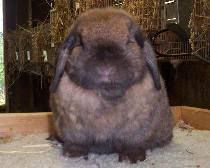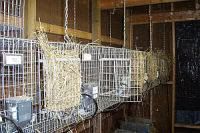by Laurie Stroupe
Timothy — Orchard Grass — Alfalfa — Hay — It’s Good.

I believe in hay.
As you can see from these pictures of the inside of my barn, you know that I don’t spare the hay. I like to feed my bunnies a constant supply, not just a handful every other day (which I believe to be the absolute minimum).
The benefits of hay are many.
- It helps wear down your rabbits’ teeth so that they don’t overgrow
- It provides the high fiber that rabbits require for gut motility
- It keeps rabbits from being bored; pulling strands of hay from a rack or a holder is an activity for them
- It gives your rabbit something to eat once the pellets are gone; rabbit digestive systems need to work constantly
- It helps prevent obesity since hay is much lower in calories than pellets or treats
- It helps relieve stress (now don’t say you can’t relate – ever had a bowl of ice cream because you were upset?)
There are probably other benefits of hay as well. And the down sides are few. Hay is messier than feed. Locating a good supply of hay can be problematic. Storage of hay can be a challenge.
I use orchard grass in my barn. If I could find a good source of reasonably priced Timothy hay, I would use that. I have friends who use coastal Bermuda and love it. You can also use fescue hay. You can even chop down and dry your own overgrown lawn (not that you’d ever have one of those) as long as your lawn is not chemically treated. Do not use alfalafa; the protein level is too high and it can contribute to obesity and digestive system problems associated with too much protein.
How to Choose a Good-Quality Hay for Bunnies, Pet or Show the same
 Good hay is dry, relatively dust-free, and mold-free. It has a fresh wonderful smell. The best load of hay I’ve had this year smelled almost good enough for me to eat. Almost. Look for some of the green color of the hay to still be present. I try to avoid hay with too many thorns in it (I think an occasional one is unavoidable). I also do not like to have too many unidentifiable weeds. I’m not so concerned if I notice some dried red clover in the hay.
Good hay is dry, relatively dust-free, and mold-free. It has a fresh wonderful smell. The best load of hay I’ve had this year smelled almost good enough for me to eat. Almost. Look for some of the green color of the hay to still be present. I try to avoid hay with too many thorns in it (I think an occasional one is unavoidable). I also do not like to have too many unidentifiable weeds. I’m not so concerned if I notice some dried red clover in the hay.
Although I enjoy getting fine, even textured hay, I’m of two minds about that. First, the fluffy stuff makes wonderful nest box liners. The rabbits usually go crazy over it when I can get it exactly like I like. But with the hay that is more coarse, the rabbits eat that, too, even though they may not exactly go nuts. And the main thing we want to provide with hay is fiber, and coarse, stemy hay has that.
I once read an opinion that we buy the beautiful hay because it appeals to us, but in reality the coarse hay is better for the rabbits. One problem I do have with coarse, stemy hay is that it seems to be poor quality all around. That is, the bales are more often heavier indicating more moisture in the bale. There are often more thorns and weeds. There’s usually more dust and the bales are more likely to contain mold.
Of course it makes sense that those farmers who are producing the best hay are tending their fields better and using better farming technics all around. So when I can get it, I opt for the beautiful hay. When I have to get coarser hay, I still make sure it is mold-free and so forth.
I made my own hay racks from scraps of cage-building materials. Mine are huge. Smaller ones will work as well. My more recent cages have a hay rack between cages to serve double duty (keep rabbits from biting through the wire or spraying through the hay, and, in winter, it keeps the air movement down).
You can also just catch a handful of hay in the cage door to accomplish the same thing as the hay rack. Of course, if you need open the door after that, your hay will fall and that can be a tiny inconvenience, but it’s certainly no big deal. My least favorite method of feeding hay is to just put a handful of hay in the cage. More hay is wasted that way and you stand the chance of having rabbits living on moist hay until you can remove it the next day. Unfortunately, it doesn’t take long to stain the bottom of a rabbit’s foot.
You can even feed your rabbits wheat or oat straw. It has little or no nutritional value except that it provides fiber. However, rabbits are less inclined to eat straw because it doesn’t taste as good as fresh hay.
![]()
Next Article: Plant your garden to share it with your bunnies!

